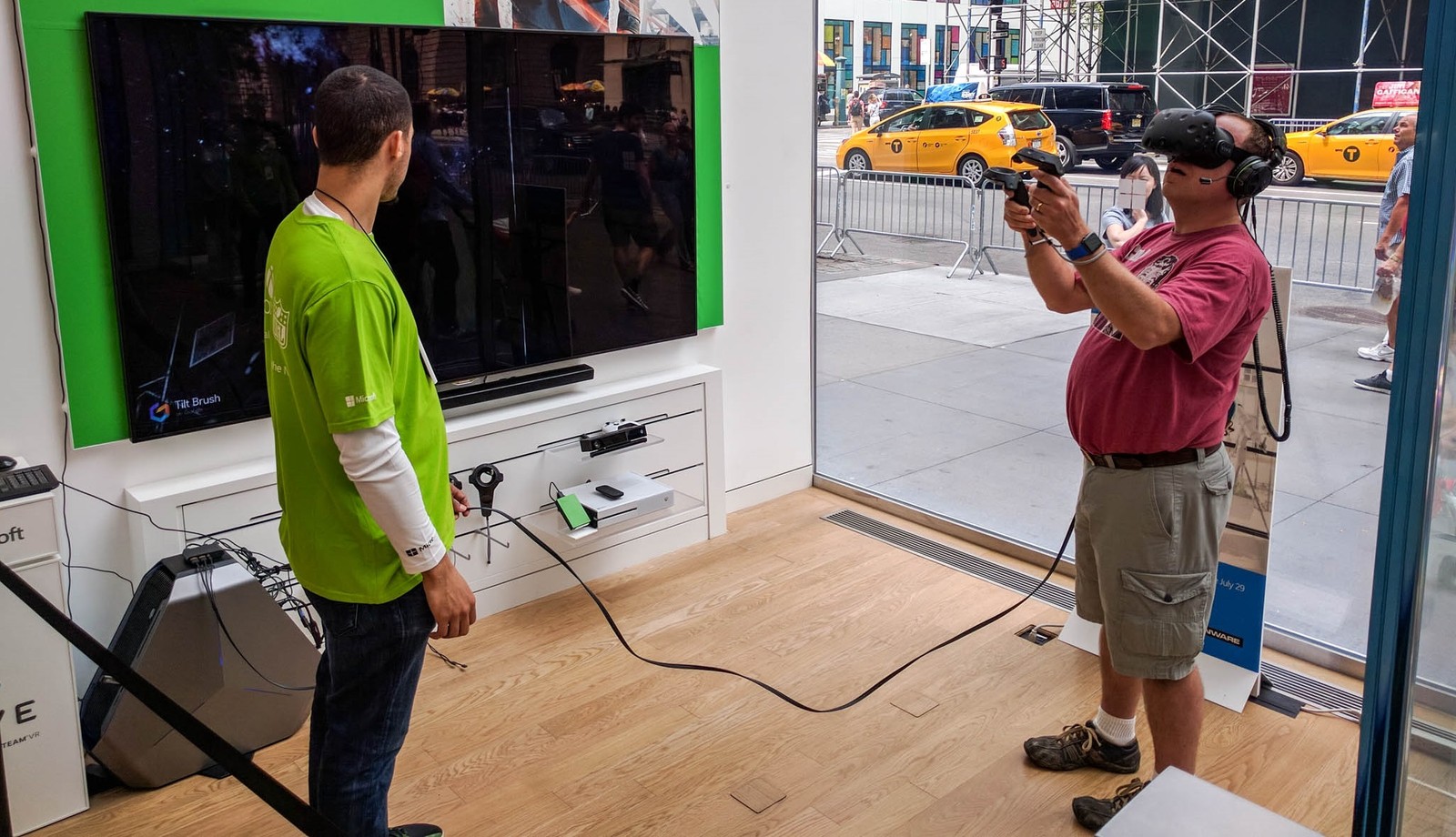In my short time as a Marketing Assistant at Filament Games, I’ve had the amazing opportunity to travel the country and show off our latest VR projects at various industry trade shows and events. From showcasing our virtual reality robotics experience RoboEngineers at I/ITSEC 2017 to demoing our VR celebration of women in science Breaking Boundaries at Madison XR’s Year End Showcase, my time spent exhibiting VR titles has offered me countless insights into strategies and best practices for how to most effectively show off VR products at live, in-person events. I’ve compiled my thoughts and observations here in the hope that other developers – in both the educational and commercial game realms – can use these strategies to improve their own virtual reality demos at live events. Without further introduction, our guide for running a flawless VR game demo at your next conference:
Pre-show
You’ll want to make sure you’re well-equipped and prepared prior to leaving for the event. This means packing the following items, in no particular order:
- Surge protector – powering a premium VR headset like the HTC Vive or Oculus Rift requires numerous power outlets…and that’s not even counting other necessary electronics like a computer and TV/monitor. Having an extra surge protector on hand will ensure you never run out of that sweet, sweet electricity.
- Snacks – as the award-winning Snickers advertisements assert, “you’re not you when you’re hungry.” Make sure you’re adequately prepared for a full day on your feet by packing plenty of on the go eats.
- Water – adequate hydration is essential for all conference-goers, especially those spending all day demoing their products!
- Throat lozenges – yes, these are important enough to warrant their very own category. These will be a lifesaver (no pun intended) after a full day of speaking loudly over crowds.
- Comfortable shoes – if you’re demoing a game at a trade show, particularly a VR title, it is likely you’ll find yourself on your feet for extended periods of time. Our take? Wear your most comfortable pairs only, your body will thank you (especially if the event spans multiple days).
- Disinfecting wipes – this one is extra important! Hundreds of sweaty foreheads and faces will rub against your VR headset throughout the duration of the event. Having a steady supply of antibacterial wipes on hand will ensure your booth is as hygienic as your game is impressive!
- Hand sanitizer – you want to bring home cool swag from events, not germs and viruses! Keeping hand sanitizer on tap at your booth will ensure your hands always remain germ-free.
- Television / computer monitor – while the most important part of a VR game demo is undoubtedly the player’s experience, it is also essential that the person giving the demo is able see the game through the player’s eyes. This is where a TV or extra monitor comes in handy, allowing you to seamlessly and effectively guide the player through the game. A laptop can make this happen in a pinch, but the larger monitor also allows passersby to see what the player is seeing, which is an excellent way to create a crowd of potential customers around your booth!
- Phone charger – conference days are long, and nobody wants to find themselves stranded at an event center because they accidentally let their phone battery fall to 0%. Having an extra charger on hand will prevent my worst nightmare from becoming yours.
- Headset cover – we’re big fans of VR Cover’s line of VR covers! Adding an additional replaceable layer of fabric in between the user’s face and the headset itself will help keep your VR device clean and fresh.
- Audio strap / headphones? – This one may or may not be essential based on your particular demo. Is your VR game linear and easy to complete without outside assistance? Using an audio strap or pair of headphones will surely provide users with a more immersive experience. However, for games that are still in-progress or more open-ended, we’d recommend skipping the headphones- while less immersive, you’ll need the demo-ee to have their ears open to your instructions and tips.
- Marketing materials – items like tablecloths, banners/posters, handouts, swag, etc. Get creative! Nobody wants to visit a booth that appears boring and unwelcoming- try your best to stand out in order to increase foot traffic through your space.

Set up
Great work so far – you’re all packed up and headed to the event center. Now what’s next?
- Show your space some love – whether a spacious booth or tiny table, items like tablecloths and banners will greatly enhance the aesthetic appeal of your space. Ideally, your decor will aid in reinforcing your game’s branding and iconography. Remember, you want your area to be eye-catching and welcoming- don’t be afraid to decorate and stand out among other organizations who didn’t!
- Turn your swag on – who doesn’t like free stuff? If feasible, bring some variety of free item to offer players after they complete your demo. Bonus points if it’s branded with your game’s logo! If swag is outside of your budget, offering players a small handout with more information about your game is a great way to help retain post-conference player interest.
- Prepare an email sign up sheet – have either a physical sign up sheet or laptop at the ready to collect contact information from players who enjoyed your demo.
- Set up early – as early as possible! That way you can compensate for any unexpected occurrences like missing hardware, dead controller batteries, or other technical difficulties.
- Meet your neighbors – introduce yourself to the folks in the booths around you! If time allows, try out their product and offer to let them demo yours. Maintaining a friendly relationship with nearby exhibitors will surely pay off in the long run- perhaps you can keep watch over each others spaces during food/restroom breaks, send conference attendees to each others booths, etc.
- Clear as much space around you as possible – especially if your game is room-scale! Allow adequate room for those playing your VR demo to walk around, but also remain conscious of the space needs of nearby exhibitors (especially if they are similarly showcasing a VR product).

Demoing Your VR Game
At long last, the section you’ve all been waiting for: best practices for showing off your VR game at a trade show.
- Offer a secure spot for players to store their belongings – whether it’s under or behind your table, it’s important to have a safe place for demo-ee’s to store their personal items. Many conference-goers carry bags or purses with them as they explore and will likely wish to remove them prior to demoing a VR game. Be sure to offer this to all interested parties- and don’t forget to keep watch over their stuff at all times, too!
- Ensure the player is comfortable – in many ways, putting on a VR headset is like wearing a blindfold…this can be extremely uncomfortable and unnerving at first, particularly for first time VR users. Start off each demo by introducing yourself to the player prior to handing them the headset. Find out what their first name is, then refer to them by that name throughout the duration of the demo. Personalizing the user’s demo will surely help them feel more relaxed and at ease, enhancing their overall experience and positive feelings towards your product.
- Ask if the player has used a VR headset before – if you’re showing off a VR game at a conference, chances are you’re well-versed and comfortable using the hardware…but don’t assume that everyone at the event has used VR before! Before handing over the headset, always ask the player if this is their first time in VR. If the answer is yes, be sure to provide extra time and assistance in helping them put on the headset and adjust to the touch controllers.
- Remind the player that they are welcome to exit the demo at any time – particularly if the player is a first-time VR user! Make sure to listen to the player throughout the demo and assist in removing the headset if they unexpectedly become overwhelmed or uncomfortable.
- Monitor the player closely throughout the duration of the demo – it’s vital to make yourself available to help if the player needs guidance towards their next objective, finishes the demo early, or starts walking head first into a real-life wall.
- Speak loudly and clearly – conference spaces are crowded and loud…make sure to speak at a higher-than-normal volume to ensure the player can hear you!
- …but don’t stand too close – that’s just weird and unnecessary, and you might get swatted by a sudden wave of the controller…
- When the demo is over, take the controllers from the player – kindly ask the player to hold their arms out in front of them, then remove the controllers from their hands. Have you ever tried to remove a VR headset while simultaneously holding touch controllers in your hands? That’s a surefire recipe for dropping expensive equipment onto a cold, hard conference floor (or if you followed my earlier advice, a carpeted, attractive, but still hard conference floor). After you’ve taken the controllers from them, let them know they are free to remove the headset.
- Disinfect headset and controllers after each demo – super important! As I mentioned earlier, countless sweaty faces and hands will make contact with your VR gear throughout the course of the event. Ensure the headset and controllers are wiped down after each user in order to promote maximum cleanliness and peace of mind for conference guests!
- If possible, offer free swag or a handout with more information about your game – especially if the player seemed to have truly enjoyed their demo experience! It is inevitable that many conference attendees will try countless new games throughout the span of their day- offering players a tangible item with the name of your VR game, its platform(s), and where/when they can purchase it will greatly improve the likelihood of them remembering your game after the conference ends.
- Thank the player for trying the game – whether they loved it or hated it, their feedback is valuable!
- …but move quickly to next person in line – nobody wants to spend their entire day waiting in lines…if there are others standing in line to play your game next, you’ll want to get them started fairly quickly. If possible, having 2+ people present to help demo is optimal, as one can focus entirely on walking players through the demo while additional hands can engage in conversation with players in line.
- If you have an extended break period (for lunch, etc.) charge your controllers – you’ve paid for and travelled to this event with the intention of showing off your game! Don’t let a dead controller battery knock your booth out of commission midday…if you have an opportunity to rest for a moment and recharge your controllers, seize it!
Congratulations- you’ve reached the end of our guide! With these tips in mind, you’ll be a VR demoing pro in no time at all. Got any other tips for showing off VR titles at public events? We’d love to hear them…feel free to reach out via Facebook or Twitter!
If you’re looking for further reading, we’d recommend checking out some of our favorite past VR blogs:
The Ultimate List of VR Game Awards
Virtual Reality for Impact
A Night of VR Exploration at Madison Children’s Museum